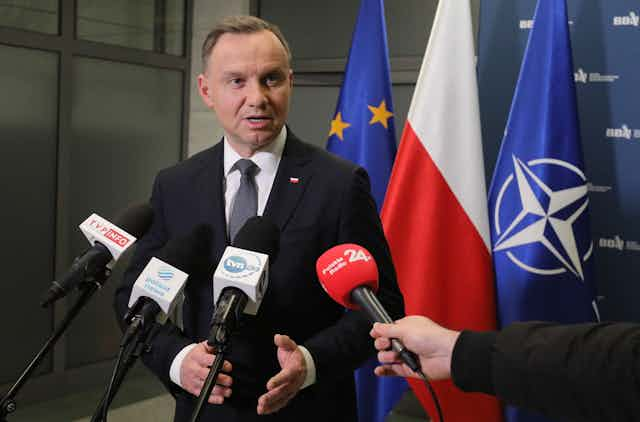Events of the past 24 hours have shown just how delicate the situation could become on Ukraine’s borders with Nato countries including Poland, Slovakia, Hungary, Moldova and Romania. Since the Russian invasion at the end of February, the big fear for the west’s most important military alliance is that hostilities could spill over into one of those countries, forcing Nato to intervene and become embroiled in the conflict.
These fears have surfaced again after a Russian-made missile landed on the village of Przewodów a few miles inside the Polish border on November 15, killing two farmers. This immediately gave rise to frantic speculation that the missile could have been launched by Russia, something which could have led Poland to invoke Article 5 of the Nato treaty.
Article 5 does not demand a military response from Nato member states. But they are mandated to “assist the Party or Parties so attacked by taking forthwith, individually and in concert with the other Parties, such action as it deems necessary, including the use of armed force”.
This article has been invoked only once before – after the al-Qaeda terror attack on New York on September 11 2001. Nato’s 1999 Strategic Concept had already identified terrorism as one of the risks affecting the security of member states. As a result, Nato launched its first operations outside the Euro-Atlantic region when it sent a force into Afghanistan to root out what it perceived to be the command and control structure of al-Qaeda.
To invoke Article 5 now, there would need to be clear evidence that the missiles landing in Poland had been fired by Russia as a deliberate act of hostility. But Poland’s president Andrzej Duda has said it is highly probable the rocket had been used by the Ukrainian air defence in an attempt to shoot down Russian missiles.
Jens Stoltenberg, Nato’s secretary general, also suggested the incident in Poland was “likely” a result of Ukrainian air defence activity. The past few days have been marked by a concerted barrage of cruise and ballistic missiles against civilian infrastructure in Ukrainian cities including Kyiv and Lviv – which is close to Ukraine’s border with Poland.

What comes next?
What are Poland’s options and what does this mean for Nato? Poland could invoke Article 4 of the North Atlantic Treaty, which states that:
The Parties will consult together whenever, in the opinion of any of them, the territorial integrity, political independence or security of any of the Parties is threatened.
Article 4 has been invoked before. Turkey did so in 2015 following terror attacks as a result of the Syrian War. And in March 2022, eight countries – Bulgaria, the Czech Republic, Estonia, Latvia, Lithuania, Poland, Romania and Slovakia – invoked the article in response to Russia’s invasion of Ukraine.
Article 4 does not have the same implications for military escalation as Article 5, so would not necessarily signify a raising of tensions. And the BBC reports Polish prime minister Mateusz Morawiecki as saying that most of the evidence gathered so far indicated it would not be necessary to trigger Article 4. But he added: “This instrument is still in our hands and we will, of course, take a decision on it.”
So it appears caution is the order of the day, at least for the time being. But what are Nato’s options in a case like this? Alliance member states have been providing limited, but increasingly effective, air defence equipment to Ukraine. Nato members are also supplying a range of weaponry including state-of-the-art tanks, NLAW anti-tank missiles and ammunition. Ukraine has also benefited from information supplied by member countries’ intelligence agencies.

Nato has been providing training for Ukrainian troops since the invasion of Donbas and Crimea in 2014. This has helped transform Ukraine’s army into the force that has been so effective in defence and, in more recent months, swift and flexible on the offensive. According to a report by Sky News in September, around 4,700 Ukrainian troops had already been trained in military bases in the UK. Other western allies, including New Zealand, Sweden and the Netherlands, have also been providing training for Ukrainian troops.
Ramping up assistance
The incident in Poland is unlikely to result in Nato deploying significantly more troops to countries bordering Ukraine or Russia. Throughout the conflict, Nato has taken pains not to be manoeuvred into a situation where it becomes embroiled in any fighting. It is also keen not to be seen to escalate tensions in the region – something that a further mass deployment would risk.
What is more likely is that Nato’s high readiness forces will be put on the alert for a swift deployment. These troops are available at short notice to deploy to areas of tension or conflict. The Brilliant Jump 2022 exercises held in Norway in March 2022, which involved 3,300 naval, air and land forces from 12 member nations as part of Nato’s Very High Readiness Brigade, focused on rapid deployment and interoperability.
So it appears that Nato’s response will be to do what it can to boost Ukraine’s ability to defend itself, while holding its forces in a state of readiness in case it is dragged into the conflict. The alliance will do all it can to avoid an escalation into an all-out war with Russia, while giving Ukraine everything but its soldiers’ boots on the battlefield.

